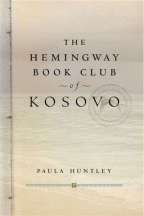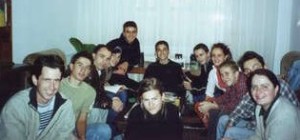March 31, 2012
Justice, Injustice, and Places of Meaning

Cover of Gaines' A Lesson Before Dying
As the students entered for the next session, I directed their attention to the board, where I had written “New Criticism,” “New Historicism,” and “Deconstruction,” as well as the names of important theorists associated with these critical approaches to literature. In applying these critical theories to Gaines’ novel, I explained, we would abandon neither feminist nor Marxist approaches, as the novel provides plenty of examples of extremely strong women and of economic inequities that reflect the Marxist critique of capitalism. But these additional critical tools, I assured the class, would enrich their understanding of Gaines’ Lesson by complementing feminist and Marxist perspectives and by providing a fuller sketch of critical thought in the twentieth century. These varied perspectives, I said, would also help us to see the connections between our theme on “Marriage, Family, and the American Dream” and our theme on “Justice and Injustice.”
Pointing to the Aristotelian communication triangle I had written on the board, I encouraged students to think of New Criticism as focused on the literary work itself, the center of that triangle. Often associated with its Southern practitioners, Cleanth Brooks and Robert Penn Warren, New Criticism, I explained, dominated American critical thought at mid-century for over three decades. Rejecting critical approaches unduly focused on the writer’s intentions (one corner of Aristotle’s triangle), the reader’s responses (another corner), or literary history (another corner), the New Critics, I further explained, insisted on an “objective” reading of a work, a “close reading” that savors the ironies and ambiguities of a given poem or fiction but finds and defends the “organic” unity of its imagery and structure. We would practice this New Critical approach, I said, as they shared their thoughts on the study questions I provided.
Continuing my sketch of critical currents, I explained that by the 1980, influenced by French theorist Michel Foucault and his concern with the “discourse of an era,” scholars such as Louis Althusser declared themselves New Historicists, critics who employed New Critical close-reading strategies but extended their analysis beyond the work itself to the cultural practices that shape a given work and define its “situatedness.” To reinforce this dual focus of New Historicism, I pointed again to the triangle, to the work in the center and to the “situation” at the ‘real-world’ corner. We would practice New Historicism, I said, when we discuss the character Grant, who, like the author, grew up in a Louisiana share-cropping culture in the 1930s; who, like the author, attended elementary school in a one-room plantation church; who earned a university degree in California, just as the author did; who returned to Louisiana, just as the author did, because of the irresistible pull of this very real place he is “unable to leave” (102), and because of his outrage over the racial injustices that defined it in the 1940s, the historical setting of the novel, two decades before the emergence of Dr. King and the civil rights movement.
Concurrent with the New Historicists, I continued, the Deconstruction critics emerged, following the thought of Russian dialogic theorist Mikhail Bakhtin and French theorist Jacques Derrida. Also deploying New Critical close-reading strategies, these critics reached decidedly un-New Critical conclusions about literature, arguing that no work possesses unity, either as a free-standing work or as a reflection of its cultural situation. Instead, I explained, Deconstruction critics argue that every “text” contains a line of interpretation that undercuts another reading, so that no fixed meaning can ever be discovered. While New Critics talk about ambiguities worked out via art into a unified meaning, I clarified, Deconstruction critics argue that the flux of a text, like the flux of life, can never be fixed, never settled beyond dispute. We would see this flux, I said, in trying to assess Grant’s teaching, his resistance to authority figures, and his relationship with Vivian.
A Lesson Before Dying
Having completed this description of critical trends and their relationship to Gaines’ novel, I divided the students into three groups, assigned each group five of the study questions I had asked them to consider as they read, and then asked them to collaborate on answers, grounded in evidence from the novel, that they would share with the whole class. I explained that they had 20 minutes to do their work, after which each group would have 15 minutes to report their findings to the other two groups. Though the students had already experienced peer-response groups, they had never worked together on an interpretive problem. Nevertheless, the pressure of the time limit seemed to distract them from anxieties over this charge to construct meaning communally; as they got to work, I roved, listening to their tentative answers, watching them scramble for evidence.
After 20 minutes, I interrupted them, telling them that they need not worry if they had not finished their task, that we would go ahead and see what each group had discovered. I then called for a report from group one, reminding them that we wanted evidence, including page numbers, not just general answers, to the questions below:
1. How does the defense attorney’s case affect your feelings for Jefferson (pages 7-8)?
2. How do you explain Grant’s anger—as a black man and as a teacher—when Miss Emma’s face (12) and Tante Lou’s words (13-14) urge him to talk to Henri about visiting Jefferson?
3. How do Grant’s feelings for Vivian and for the town (29) explain his reluctance to intervene in Jefferson’s case?
4. Describe Grant’s teaching and disciplining methods. Do they seem effective? Explain. How do Grant’s situation and the students’ lives influence and explain Grant’s harshness (29)?
5. What similarity do you see between the attorney’s defense of Jefferson (chapter 1) and the way Mr. Pichot and Sheriff Guidry treat Grant (chapter 6)?

Group 1: New Historicists at Work
Group one began by responding to #1 and #5 together, saying that they felt great sympathy for Jefferson and Grant. When I asked for their evidence, they referred to page eight, where Jefferson must endure the remarks of his attorney, who ‘defends’ him in front of the all-white jury by calling him a “hog,” not a man, a beast capable in his panic of looting the liquor store cash drawer, but incapable of thought and therefore incapable of planning the murder of the store owner. They reported sympathy, too, for Grant, a black man with a university education, who must endure the arrogance of Sheriff Guidry and Henri Pichot, powerful white men who keep him waiting for hours when he comes to ask permission to visit Jefferson in jail. “But what difference do you see between Jefferson and Grant in the way they deal with the insults?” I asked. Laureta, a member of group one, quickly observed that Jefferson keeps his head down and remains silent, but Grant reports that he has waited “two-and-a-half hours” and offers no smile, knowing that the white men expect a smile and a “not long” in response to their question, “Been waiting long?” (47) “Did you notice Grant’s verbs?” I asked her. Laureta then pointed to his saying “doesn’t” instead of the ungrammatical “don’t,” revealing his defiance of these white men, who expect Grant to show his subservience by using dialect (48).
Some of this sympathy and admiration for Grant melted away, however, when the group responded to questions 2-4. They reported understanding Grant’s anger when his Tante Lou demands that he visit Jefferson in jail, that he teach Jefferson to feel like a man, not a hog, before he dies in the electric chair, but they argued that Grant shows too little respect for Miss Emma, Jefferson’s godmother, when he tells her that he can’t make Jefferson a man, that he can only “keep others from ending up like this” (14). They also reported understanding why Grant would want to move with Vivian to someplace where he could feel alive, less stifled (29), but they had no respect at all for his use of foul language and his whining tone, especially when he says, “I’m supposed to make him a man. Who am I? God?” (31). They said, too, that they understood why Grant would be frustrated with his one-room school and inattentive students, but they roundly condemned Grant’s cruelty to his students, releasing his own stress by shouting in their faces and hitting them with a ruler for lapses in concentration, for writing crooked sentences on the board and for playing with bugs (35-41).
Congratulating this group on their excellent work, I called on group two. Apologizing for coaxing the first group into answering their question on Grant’s use of language to assert manhood, I asked for their comments on questions 7-10:
6. How does Grant use language to assert his manhood in chapter 6?
7. At the top of page 62, Grant compares the “old men” laborers to the student woodchoppers. What do his thoughts reveal about his goals as a teacher? Why had his former teacher urged Grant to “run”?
8. Why does Grant believe his aunt is “stripping” him of “everything you sent me to school for”?
9. Give two reasons why Grant tells Jefferson that he will “lie” to Emma about Jefferson’s refusal to eat.
10. Why do Grant’s memories of Joe Louis and the old men’s talk of Jackie Robinson—both black sports heroes—make Grant think of Jefferson? What irony do you see in the achievement of these heroes?

Group 2: Deconstruction Critics at Work
This group commented first on #8-9, for their answers here, they said, return Grant to a more favorable light. To this point, they argued, Grant’s visits to Jefferson have confirmed his reasons for resisting this seemingly impossible job of persuading Jefferson of his manhood. When I asked, “How so?” they pointed to Jefferson’s sarcasm about his execution date, his eating from Emma’s food bag on all fours, like a “hog”; then Arlind read Grant’s passionate speech aloud:
Everything you sent me to school for, you’re stripping me of it….The humiliation I had to go through, going into that man’s kitchen. The hours I had to wait while they ate and drank and socialized before they would even see me. Now going up to that jail. To watch them put their dirty hands on that food. To search my body each time as if I’m some kind of criminal. Maybe today they’ll want to look into mouth, or my nostrils, or make me strip. Anything to humiliate me. All the things you wanted me to escape by going to school. Years ago, Professor Antione told me that if I stayed here, they were going to break me down to the nigger I was born to be. But he didn’t tell me that my aunt would help them do it. (79)
Gezim mentioned, too, that Grant really impressed him at the end of the next visit to the jail, when Grant tells the still-hostile Jefferson that he intends to lie to Emma about Jefferson’s refusal to eat her pralines because telling the truth, he tells Jefferson, “would kill her”; he also tells Jefferson that he plans to return so that the “white man” can’t “win” (84).
Everyone agreed that such language makes Grant seem much less whiny than he seemed at first, more combative, even daring. When I asked what they learned about Grant from his thoughts on the woodchoppers in #7 and the old men in #10, Dafina stressed Grant’s compassion for his students, many of whom would end up as woodchoppers (61), and his compassion for Jefferson in that “depressing cell uptown” while the old men at the bar can only talk about their boxing hero Joe Louis and their baseball hero Jackie Robinson (90). Praising these insightful answers, I asked them to consider how Grant’s compassion here would attract the interests of a New Historicist or Marxist critic, who would see Grant’s thoughts as a commentary on the rural South in the 1940s, when most black children really had no access to the American Dream, a time when even black heroes like Robinson and Louis could stir hope but do nothing to change the everyday reality of the plantation. “And what might a Deconstruction critic want to point out about the Grant we have seen so far?” I asked. Blerta responded by describing the two narratives on Grant, the cruel, selfish whiner and the bold, compassionate man.
Finally, with little time remaining, we turned to the third group for their report on these questions:
11. How do you explain the tension and anger between Grant and his Aunt, and between Grant and Reverend Ambrose?
12. What does Grant mean when he says he is “unable to accept what used to be my life, unable to leave it”?
13. This novel on racism and injustice is also a love story. How does Grant’s tenderness for Vivian affect your view of him? What effect might their love have on Grant’s ability to “teach” Jefferson to be a man?
14. At the end of chapter 18, Grant wants to give up on Jefferson, but Vivian insists that “something is changing” (141). What evidence do you see in chapters 16-18 that suggests that Grant and Jefferson are both changing?
15. In chapter 19, why does Gaines provide so much detail about the Christmas party, the play, and Ambrose’s prayer? What irony do you see in Grant’s prominence at this event as the director of the children’s play?

Group 3: New Critics at Work
When I asked if they saw any irony in Grant’s prominence in the town as Jefferson’s teacher (#11) and as the director of the annual Christmas play (#15), Ragip said that Grant’s apparent atheism makes him an outsider in a church-going community led by Reverend Ambrose, who humiliates Grant by praying publicly, before and after the play, for doubters like Grant who think they don’t need God. When I asked if this tension between belief and doubt explains the quote in #12 about Grant being “unable to accept what used to by me life,” Ragip agreed. “What about #13? Do you see the same Grant you saw earlier in his relationship with Vivian?” I asked. This question led to some blushing and looking down at desks, but Albana spoke up, saying she admired the tenderness she sees in Grant’s love-making with Vivian (108-109). “And Vivian believes in God,” Albana added, smiling; “Maybe she will change Grant’s mind on that topic.” “Do you see any irony in her dual roles as believer and as Grant’s lover?” I asked. “Remember that Vivian’s divorce has not been concluded yet, so this romantic scene also raises issues about adultery. Do any of you have concerns about her morality?” I prodded. Wisely, Albana said that “life gets complicated.”
“Do you think that Vivian has a point that “something is changing” in Grant, particularly in his relationship with Jefferson?” I prompted. Gezim responded with Grant’s comment that he “wasn’t so angry anymore” (125), reflecting Vivian’s influence; he also applauded Grant’s defense of Vivian after Jefferson crudely insults her: “That lady you spoke of, boy, cares about you” (130). “Does this flash of anger in defense of the woman who keeps Grant “coming here” have any impact on Jefferson?” I asked. Several voices spoke up, citing the “tears in those big reddened eyes” (130), a major crack in Jefferson’s wall of resistance.
With our time ending, I reminded the class that we would finish discussing Lesson next time and that they should write journal responses to two more of the remaining 13 study questions, all focusing on this transformation of Jefferson and Grant that we had already begun to see.













